
Provocative text and images can spark great discussions with students. With Edji, students can have rich discussions easily online.
Texts and images related to the content we teach can spark students’ imagination. Provoke controversy and fierce debate. Inspire them to see themselves — and the world differently.
But done poorly, they can be one-dimensional learning. Fact recall-based. Anything but memorable.
What makes the difference?
What causes some lessons to flourish and others to flop?
There are lots of answers. But for me, it’s always come back to this …
Interaction.
- Are students interacting with each other?
- Are they interacting with the content in meaningful ways?
- Do those interactions spark discussion and debate?
- Do those interactions show them something new about what they’re learning?
Creating great interaction can be hard. Face-to-face interaction can lead to awkward “think pair share” activities and class discussions where only three students participate.
Digital interaction can lead to a “how many comments do I have to write?” scenario where too many comments are one word or one uninspired sentence.
Let’s set students up to succeed in interactions around our great texts and images.
I think Edji can help.
What is Edji?
Edji (edji.it) lets students read and annotate that content with text comments, audio recordings and even emojis.
The teacher creates a “reading” (combination of text, images, questions and more) and students interact with the reading.
It can create discussion. Collaboration. Community, even.
Edji is free with a $60/year upgrade to “hero” status.
- Free users are limited to two active readings — your two most recent ones. All others are frozen, disabling commenting and copying unless you upgrade to hero. (But as fast as it is to create an Edji reading, you may not even need hero status.)
- All users — free and hero — get a variety of comment types, PDF and image upload, Heat Vision (allowing the teacher to toggle on/off student view of comments) and more.
- Hero users get student analysis tools (like student reading recaps) and custom-created join codes.
There are ways to make the most of a free account despite the limitations. (See bottom of this post for ideas.)
How can I use Edji?
Start by registering with a free account. After you’re set, here are 20 ways you can use Edji with your students:
- Create a reading with text, images, questions and/or PDFs. Click the “Write” button in the top left. Then, click the “New Reading” button in the top left.
- Once you’ve created a reading, share it quickly with a code. After you’re done making your reading (tips on doing that below), you’ll get a code. Students go to edji.it and enter your code to join and get started.

- Add comments to anything with a click. When students view the text, images and/or PDFs you’ve added to your reading, they can click almost anything to add a comment to it. With text you’ve added to your reading, students can click and add comments on individual words.
- As teacher, turn feed on to see comments in real time. Want to see every comment come in as they’re written? The feed will show you the most recent at the top, kind of like a social media feed.
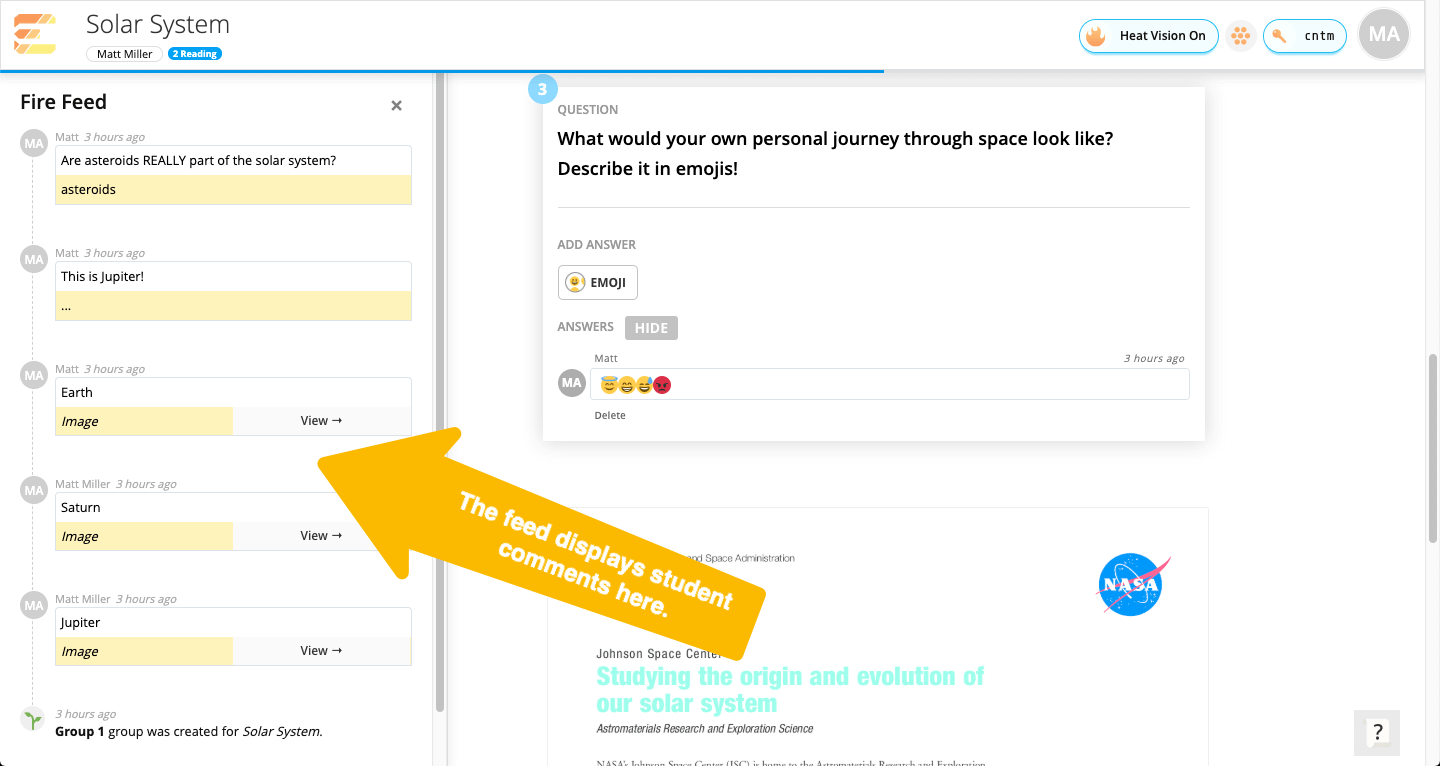
- Comment on historical photos/art, current events photos, diagrams, charts and more. Add images to your Edji reading. Students comment by clicking a specific part of the image. It drops a dot in that location, and students add a comment to the dot.

- Copy text over for students to analyze (poetry, articles, Wikipedia). Copy/paste text from anywhere to let students discuss it.
- Use text from different sources to compare. Want to look at how different sources treat the same subject? Copy over text from two very different sources and encourage students to drop comments on differences they notice.
- Use Google News Archive to find images of old articles to analyze. Want students to reflect on how the news covered an event in history? Find a historical newspaper article in the Google News Archive (news.google.com/newspapers). Take a screenshot and add it as an image to your Edji reading.
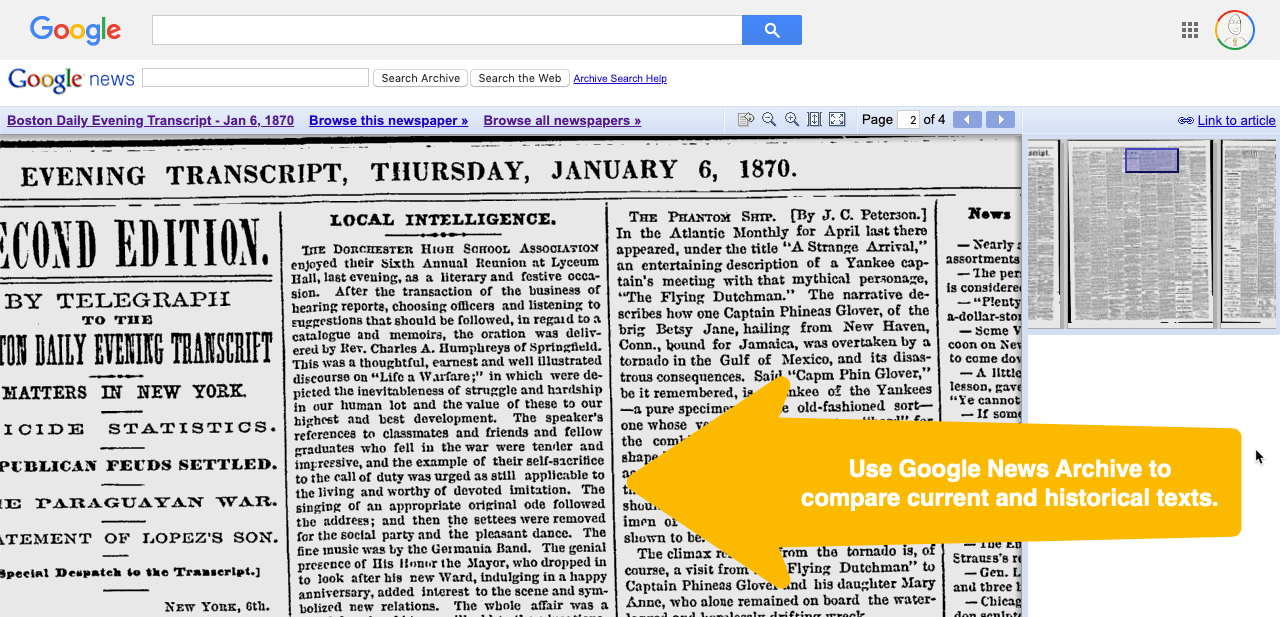
- Copy/paste student work to analyze and/or offer feedback. Students can analyze or comment on each other’s work. Teachers can make an Edji reading where they copy/paste student writing.
- Use text from an opinion piece to let students agree or disagree. Opinion writing, like an editorial or a blog post, can force students to take a stand and support or disagree with the author. Great content drives great discussions.
- Take your own photos and add comments. Build class community by creating a fun Edji reading with pictures of your class from school or a field trip. Students can click on the images to leave comments.
- Create images with Google Drawings. Teachers aren’t limited to images they can find in image searches. Create your own images with Google Drawings (drawings.google.com). Add a graphic organizer (with one of these free templates). Create a seating chart image and have students click their seat and add a comment to answer a question. Create a strongly agree/strongly disagree line and let students click where they feel, adding a comment to explain why.
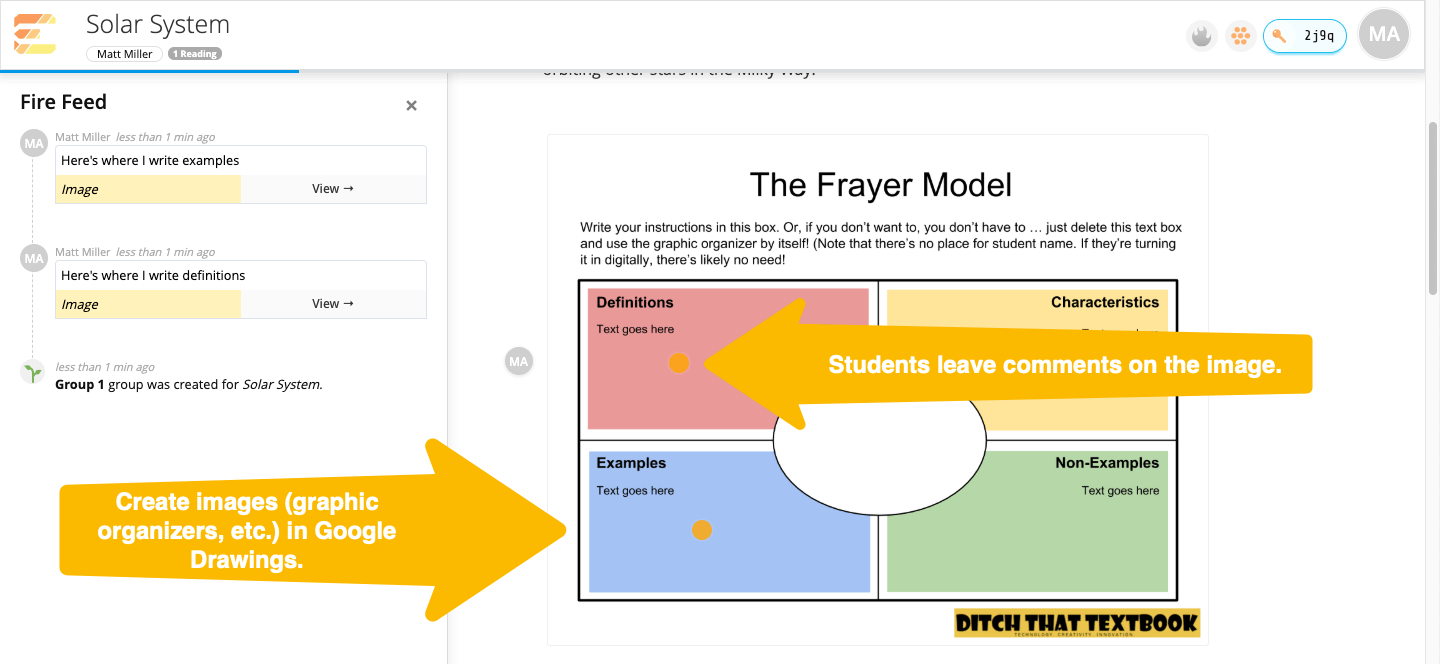
- Students can add dots to PDFs, too. Have a PDF file you’d like students to analyze? Upload it to an Edji reading. Students can click to add a dot and a comment like an image. This works for documents and slides, too. Under the File menu, save them as a PDF file and add them to an Edji reading.
- Insert questions to gather student insights and check for understanding. Among the text and images in your Edji reading, add questions that demonstrate understanding or ask for student reflection and opinions.
- Use text questions to gather factual answers and to let students reflect. Students type these text questions with a keyboard. They’re great for quick answers or where an audio recording from every student would be hard.
- Use audio questions so students can talk out their answers. Hear students’ voices — and their intonation and inflection — with audio responses.
- Use emoji answers for quick reflections and even emoji stories/poetry. The emoji answer type lets students respond with a single emoji — or even a string of them to tell a story or a message visually.
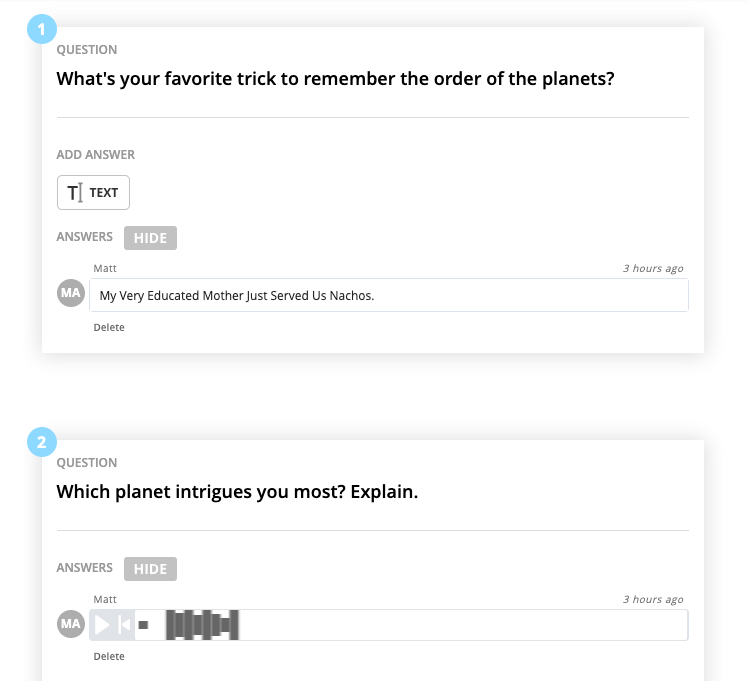
- Use Heat Vision to let students see each other’s comments. When you toggle Heat Vision on, students can see each other’s comments.
- Turn heat vision off to let students answer by themselves. This is good for recall-based, factual answers — especially those where most responses will be the same.
- Turn heat vision on to check class comprehension or see variety of responses. This is good for debriefing after students have written comments — or to let students discuss live on matters of opinion or reflection.
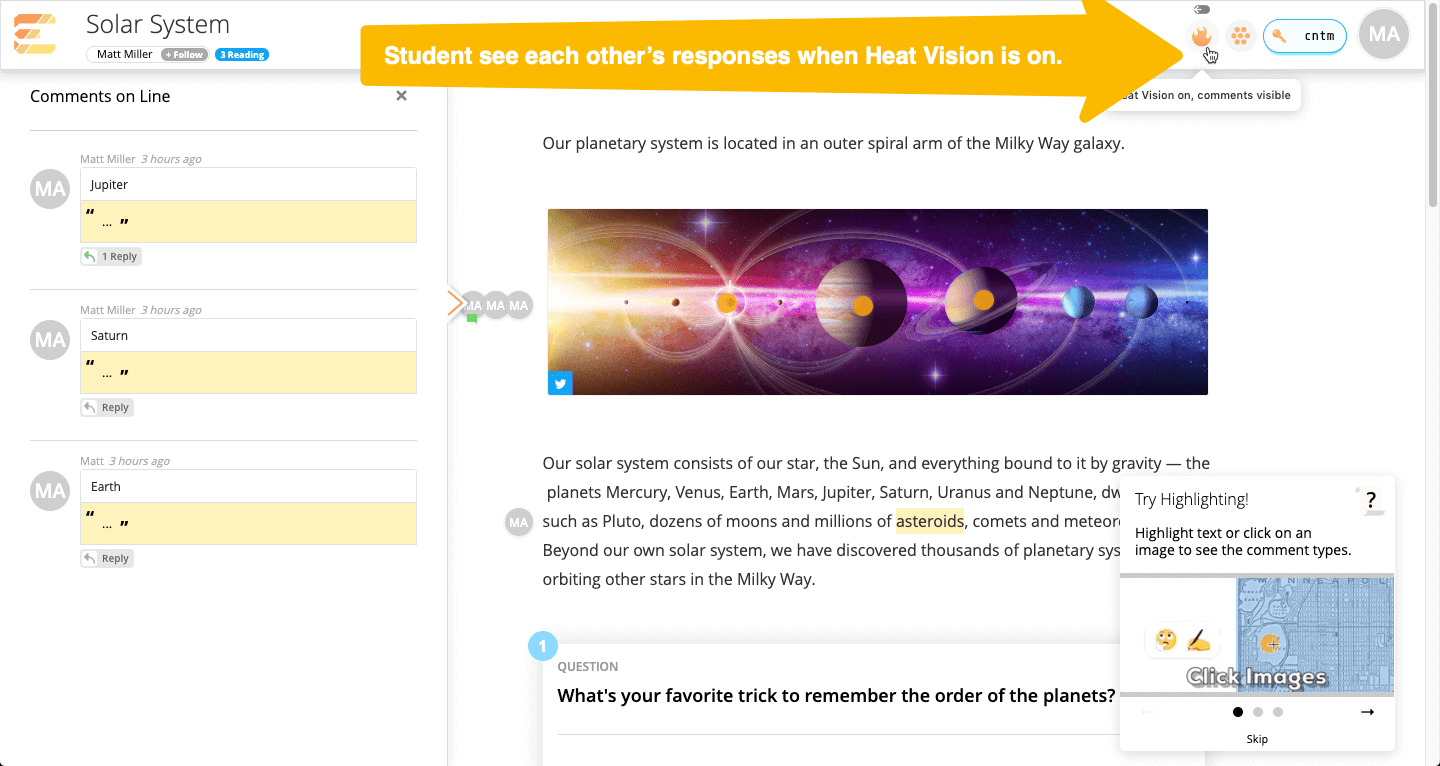
The big question for me after using Edji is this …
What texts and images do you want students to discuss — and what do you want to ask them?
A quality question can drive great discussion, but letting students notice and discover can be just as powerful.
How to exist with the free plan
The free Edji plan (2 active readings at a time) can seem pretty limiting. If you love the concept but can’t come up with the $60/year, here are some strategies to make do:
- Create lots of new, small readings. Creating a new Edji reading can be done in just a minute or two. In fact, very simple ones could be done on the fly with students in the room. If your mindset going in is that your readings aren’t going to be saved, you might be less disappointed with having only two.
- Use groups. You can create one reading with multiple groups. If you have multiple classes of students in a day, you can make a single reading and have a different group for each class. This also works if you want different groups of students commenting with each other within a single class.
- Save your text and images somewhere to reuse later. Create a folder in your Google Drive (or computer hard drive, or Microsoft OneDrive) and save images and/or PDFs for a reading there. Create a document and copy/paste text in it. If you have everything you’ll need, recreating Edji readings won’t take that much time in the future.
Now get started, and get your students discussing!
Note: Edji has no relationship with Ditch That Textbook or Matt Miller, the author of this post. Edji has provided no compensation — monetary, goods or other resources — in exchange for this post or to Ditch That Textbook or Matt Miller at all. It’s just a classroom resource we love and wanted to share!
For notifications of new Ditch That Textbook content and helpful links:
Interested in having Matt present at your event or school? Contact him by e-mail!
Matt is scheduled to present at the following upcoming events:
[getnoticed-event-table scope=”upcoming” max=”15″ expanding=”false”]









